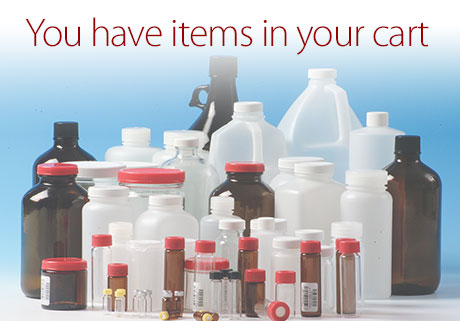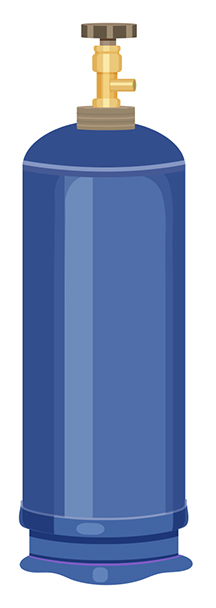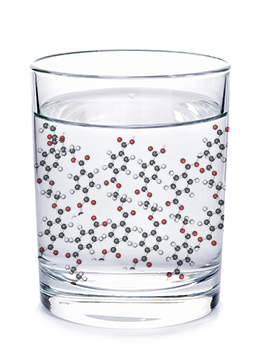 Autumn • 2020 Autumn • 2020 |
In this Issue: |
|
|
Ethylene Oxide rapidly gaining attention The pervasiveness of per- and polyfluoroalkyl substances in the environment, particularly the water supply, continues to draw the attention of scientists and the public. However, numerous other chemicals are gaining notoriety due to their distribution and public exposure. One such compound is ethylene oxide (EtO), which is rapidly becoming an issue because of a different route of exposure – inhalation, rather than ingestion. EtO is a flammable, colorless gas used in processes to make a range of products, including antifreeze, textiles, plastics, detergents, and adhesives. Its most controversial use is as a sterilizer for equipment and plastic devices that cannot be sterilized by steam (autoclaved), particularly medical equipment. US EPA recently updated its risk value for EtO and is working with industry, state and local regulators to address this chemical. EtO is a hazardous air pollutant that is emitted from several types of industrial facilities that are regulated by US EPA. Thus far, EPA has not tightened limits or obligations for medical sterilization plants. It is these plants that are often creating local headlines. Ethylene oxide’s characteristics and use have also drawn the attention of The Occupation Health & Safety Administration (OSHA), which has published related guidance and information. EtO is both flammable and highly reactive, possessing several physical and health hazards that merit special attention. EtO is used extensively by hospitals and other industries as a sterilizing agent. EtO is a virtually odorless gas, which you cannot smell until it reaches levels that can cause serious harm. Human and animal studies consistently show that EtO can be hazardous to human health. Short-term exposures to EtO can cause respiratory irritation and lung injury, shortness of breath, headache, nausea, vomiting, and diarrhea. Long-term exposure over many years may cause cancer, reproductive effects, genetic changes, and damage to the nervous system. Exposures to EtO are addressed in specific OSHA standards for general industry, maritime, and construction. OSHA’s “action level” is the 8-hour exposure level that triggers certain actions under OSHA’s EtO standard. If an employee’s 8-hour sample result is equal to or greater than the action level, the employer must start certain required activities such as exposure monitoring and medical surveillance. The action level for EtO is 0.5 ppm (which equals 0.9 mg/m3). Measuring EtO in the air requires a careful analytical-chemistry solution that industry, regulators, and impacted communities are widely ignoring. As EtO continues to hit the headlines, laboratories and other monitoring entities need to be using high-quality data so they can be certain that the reported concentrations comply with regulations – defensible data that can be reliably used for reporting, decision-making, and remediation where necessary. Source: |
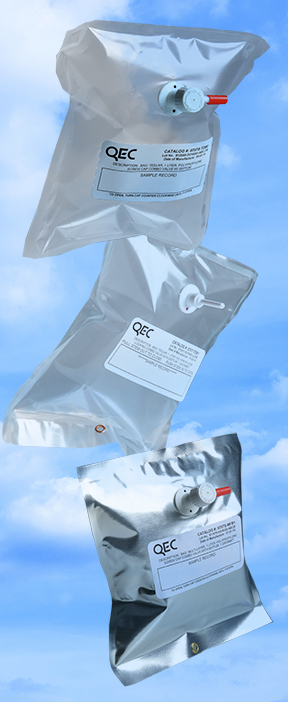 |
QEC air sampling bags Sampling bags are a low-cost whole air sampling device for high level VOCs and permanent gases. Several EPA, NIOSH, and OSHA methods exist for bag sampling for a variety of applications: stationary sources emissions; workplace atmospheres; ambient, indoor air quality; and breath analysis. Choose the film type appropriate for your application. All our bags feature a polypropylene combo valve with hose connection to fit 3/16" ID tubing and syringe port with replaceable septum. A single eyelet provides handling convenience.
Protective 5-layer barrier minimizes gas permeability
For complete information on QEC’s line or air sampling bags and available fittings, please contact QEC's Customer Service Team (800-255-3950).. |
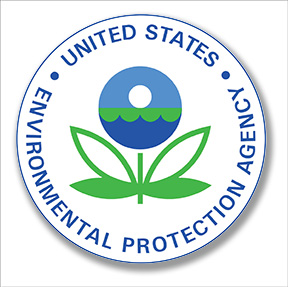 |
EPA clarifies SW-846 holding time guidance At the urging of the American Council of Independent Laboratories (ACIL), the US EPA has issued new guidance to clarify sample holding times for the SW-846 program. According to EPA’s letter to ACIL, “The new guidance on sample holding times for the SW-846 program is: “Holding times for sample preparation and analysis greater than or equal to 7 days have been met if the sample is prepared or analyzed by the end of the last day or month of the specified maximum holding time. For example, a sample collected on a Tuesday is considered to have met a specified 7-day holding time as long as it is prepared or analyzed by the end of the day on the following Tuesday. A sample collected in January is considered to have met a specified 6 month holding time if it is prepared or analyzed before the end of July. “The SW-846 Methods Team will revise guidance related to holding times to be consistent with the interpretation above, and this interpretation will also be incorporated into Chapters 3 and 4 at the next available opportunity. “It is also important to point out that authorized states can be more stringent when designating holding times or interpreting guidance on measuring holding times.” Sources: American Council of Independent Laboratories: acil.org/news/?id=15225
|
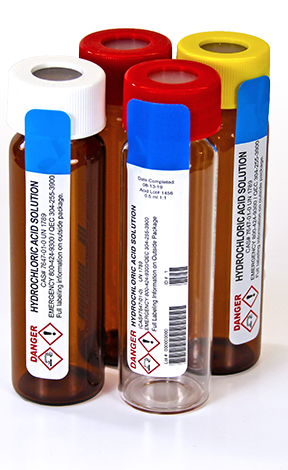 |
HCL preservative purification Most of the commercially available hydrochloric acids exceed EPA quantitation limits for certain contaminants, making those acids unsuitable for VOC preservation? Vials certified for low-level VOC need to be preserved with HCl that meets or surpasses EPA standards. EPA guidelines for contaminant-free sample containers recommend there should be no more than one half of the CLP’s Contract Required Quantitation Limit (CRQL) contributed by the container. Surprisingly, the majority of the commercially available acids tested exhibited levels exceeding the CRQL when used as a preservative. QEC uses its own unique procedure to remove or reduce preservative contaminants to better than acceptable levels before adding the HCl to our vials. The table below shows the volatile organic composition of a 1:1 solution of HCl and VOC-free water before and after our treatment process. The result is HCl preserved vials that are absolutely trustworthy for VOC preservation and analyses. Certificates of Analysis for vials and acid can be produced upon request. For more information on preservative preparation and QEC’s Custom-Preserved™ products and services, please contact QEC's Customer Service Team (800-255-3950).. |
|
|
Microplastics in drinking water Since John Wesley Hyatt first combined cotton cellulose and camphor to create an ivory substitute to make billiard balls, the world has become reliant upon the synthetic polymers commonly called plastics. The huge societal benefits gained through the invention and use of plastics in everyday life have come at a cost as discarded plastic materials have polluted the environment. Increasingly, scientists have turned their attention to understanding the many different effects plastic waste may have on public health and the environment. One area of growing concern has been the presence of microplastics in the environment, and the potential for these tiny particles to make their way into our food and water. Microplastics fall into two main categories—those that are manufactured as additives or for use in manufacturing and those that come from the degradation or breakdown of larger plastic particles. There is good cause for concern since these particles are ubiquitous, having been found at the bottom of the ocean and in the most remote geographic locations. Microplastics are being dispersed in a variety of ways, many of them related to the decomposition of plastic bags, bottles, and other plastic items which find their way into rivers, lakes, estuaries, and oceans. Not surprisingly, tire wear is estimated to contribute as much as 28% of the microplastics now polluting the ocean. Particles present in stormwater runoff make their way to the ocean, entering the food chain of the shellfish and fish we consume. Researchers are still trying to understand the prevalence and impact of this phenomenon. Unraveling the scope of this problem begs the question: How much concern is warranted? The World Health Organization published a report in 2019 concluding that although microplastics have been reported in drinking water and certainly appear to be ubiquitous in the environment, there are no apparent human health effects. However, the report encouraged further research to advance our understanding. California’s state legislature directed the State Water Resources Control Board (SWRCB) to investigate the prevalence of microplastics in drinking water and adopt a definition by July 1st of this year. The bill further requires the Board to adopt a method of analysis for the determination of microplastics, accredit laboratories to perform the method, and establish the framework for a four-year drinking water study to collect data and make it public by July 1, 2021. While many organizations and previous researchers have defined microplastics in different contexts related to their purposes, California will be the first governmental entity in the world to establish a regulatory definition for drinking water. The definition, published on March 19, 2020, has been specifically created to address the substance, state, and dimensions of a microplastic. It defines a microplastic as a solid polymeric material with at least two dimensions between 1 and 5,000 micrometers. The complete definition, which excludes naturally occurring polymers that haven’t been chemically altered, can be found on the State website (https://www.waterboards.ca.gov/drinking_water/certlic/drinkingwater/documents/microplastics/def inition_microplastics.pdf), along with the complete staff report https://www.who.int/water_sanitation_health/publications/microplastics-in-drinking-water/en/ © 2020 | Quality Environmental Containers, Inc. |
